Glazo
Glazo started out as a liquid nail polish but evolved into a complete manicure range. Its creation is often credited to Edna Grace Albert who is better known for Odorono, an antiperspirant invented by her father.
See also: Odorono
Glazo creation stories vary but generally have Edna developing the polish after noticing that French women were using liquid nail polish in preference to buffing their nails.
Created for women by a woman, Glazo is the inspiration of Edna Albert, one of America’s most successful business women. She combed all Europe for nail polishes, tested them all, learned their advantages and shortcomings and perfected Glazo in her own laboratories. It was America’s first liquid polish.
(Glazo advertisement, 1928)
This exquisite polish was created for women by Edna Albert, one of America’s foremost business women. She searched the exclusive toilet goods shops of Paris for a truly distinguished nail polish—brought back a secret formula and then perfected it in her own laboratories.
(Glazo advertisement, 1929)
These origin stories are fabrications. Edna did not develop Glazo but rather acquired it when she bought of The Glazo Company of Fort Wayne, Indiana in 1918. This company was founded by William Henry Noll [1875-1941], who made a fortune selling Pinex Cough Syrup. It had been operating since 1914, with Noll trademarking the name Glazo in 1915.
Edna’s other claim, that Glazo was America’s first liquid polish, is also untrue. Although Glazo arrived two years before Northam Warren began marketing his Cutex Liquid Nail Polish, there were other liquid nail polishes sold in the United States before 1914.
See also: Nail Polishes/Enamels
After Edna bought Glazo she incorporated the company in Cincinnati in 1918 (capital US$25,000) and began advertising Glazo Nail Polish in 1920. The polish was initially pricing at around 50¢ a bottle but the post-war slump of 1920-21 soon saw its price drop into the 30¢ range. By 1921, she had also introduced Glazo into Canada using John A. Huston Co., Toronto as her distributor.
Products
Edna was advertising two products in 1920, Glazo Nail Polish, and Glazo Cuticle Massager. It is possible that the Cuticle Massager did not come with the 1918 purchase and was added later.
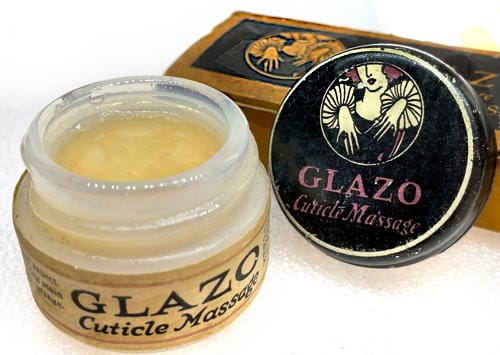
Above: Glazo Cuticle Massage Cream with a Glazo Minature Manicure Set in the background.
The nail polish was sealed in bottles to reduce evaporation and was applied brush that came separately. In the larger bottles the brush was fixed into a cork which was then used to stopper the bottle after the seal was broken, a situation that commonly applied to all nail polishes before the 1930s.
The cork would prevent spillages but it did not completely stop the evaporation of the solvent. One way to reduce evaporation was to lay the nail polish bottles on their side. Edna appears to have recognised this and changed the shape of the Glazo nail polish bottles in 1922 from round in cross section to triangular which made it easier to lie the bottles down.
As far as I can tell Glazo only came in a shell-pink tint when it was first introduced. This could have been created by adding a little dye to the polish mixture. The aim was not to noticeably colour the nail plate, as is the case with most nail polishes today, but rather to produce a translucent natural-looking finish. A second shade was added in 1928 when Glazo polish then came in Natural, and Deep.
The lovely glimmer given to the nails by Glazo is neither too deeply pink nor too pale—just cleverly in-between—a natural, soft radiance that is subtly sophisticated—that is utterly new and correct.
(Glazo advertisement 1929)
Glazo Liquid Nail Polish: “[A]pplied in a moment and lasts a week. It forms a protective film on the nail and gives you an attractive lustre that is undimmed by water or soil. It keeps your nail constantly polished and they will always look as though they had just been manicured. Glazo Polish does away with harmful buffing which causes ridges and brittleness.”
Glazo Cuticle Massage: “[W]ith its soothing, healing magic, quickly remedies the harmful effects of harsh treatments, and gives to the nail sheaths the soft, velvety charm, the smoothness and lovely glow of perfect health.”
Like many early nail polishes, Glazo was used as its own remover at first by painting on the polish and then removing both it and the old polish before it could dry. However, women would get a better result if they used Glazo Polish Remover which first appeared in 1921. It was combined with Glazo Liquid Nail Polish, and Glazo Cuticle Massager to form the Glazo manicure routine, described as ‘A new way to manicure’ as it required no buffing.
1—Trim nails, and, with an orange stick dipped in Glazo Cuticle Massage, press back and shape cuticle. Then bathe fingertips in warn soapy water and wipe dry.
2—Next, dip brush into Glazo Polish and touch each nail lightly, covering each nail completely with thin film. Allow moment for drying, then dip nails in cold water, dry and rub briskly with towel or palm of hand. Do not buff.
3—To renew Glazo, first clear nails of all former polish with Glazo Polish Remover. Apply Remover to one nail at a time and rub off immediately while wet. Then repeat for Glazo Manicure as before.(Glazo advertisement, 1921)
In 1927, Edna opened a combined office for Glazo and Odorono in New York. The following year Glazo added a Glazo Cuticle Oil to its range with the older Cuticle Massage Cream becoming Glazo Cuticle Cream.
Glazo Cuticle Oil: “[T]o frame the nails in exquisite pink cuticle ovals which are the perfect setting for dainty, white half-moons. For those who prefer a cream to an oil, Glazo Cuticle Cream is a marvelously healing preparation.”
Some of the Glazo advertisements from 1928 featured Rosalinde Dunn, described as a “well-known authority on manicuring whose clientele is the most fastidious in the world”. In some of Dunn’s endorsements she claimes that ‘Glazo has IT’. This is a euphemism for sex appeal, a term brought to America from England by Eleanor Glyn [1864-1943]. IT featured prominently in the box-office hit ‘IT’ released by Paramount in 1927. Glazo had previously done a tie-up with Paramount in 1925 with their picture ‘The Manicure Girl’ staring Bebe Daniels [1901-1971].
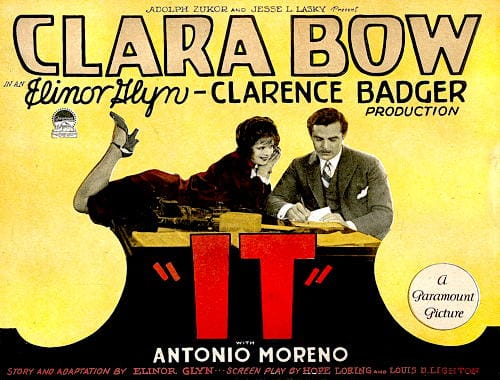
Above: 1927 Movie poster for ‘It’ starring Clara Bow [1905-1965]. Known as ‘The IT girl’ she came to personify the modern woman of the 1920s.
In 1928, Edna began registering the tradename Galo in Britain and the British Dominions which suggests there was a trademark conflict with the name Glazo there. However, her expansion plans were forestalled by Northam Warren [1878-1962], the owner of Cutex, buying Glazo and Odorono from her in December, 1928 for US$4 million.
See also: Northam Warren
Northam Warren
After acquiring Glazo and Odorono, Northam Warren recapitalised and created to new companies, Glazo Co. and Odorono Co. in New York in 1929, each consisting of 200 shares of common stock. Both companies were based at 191 Hudson Street, New York. Initially, the Glazo sales force remained separate from Cutex but the two teams were merged them in 1932, thereby greatly increasing Glazo’s sales prospects.
Northam Warren was already selling Cutex overseas and he introduced Glazo into Britain in 1930 sone must had sorted out the trademark problems that forced Edna to used the name Galo instead. Sales were initially through Harry A. Penney Co. Ltd. before Northam Warren establishing Glazo Ltd. (capital £1,000) in London in 1934 with Eucryl Ltd. as its distributor. Glazo become available in France soon afterwards.
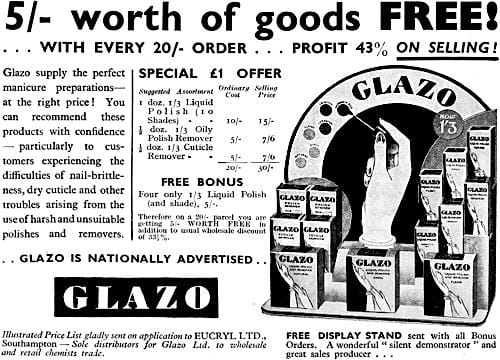
Above: 1935 Glazo Ltd. (Britain)
Products
Northam Warren made a number of changes and additions to the Glazo range starting with the release of Perfumed Glazo Nail Polish in 1929 in four shades – Natural, Flame, Geranium, and Crimson. These were to be matched with the lipstick a woman was wearing. Women using a light shade of lipstick were advised to select Glazo Flame, medium lipstick shades went best with Glazo Geranium, and for darker lipsticks there was Glazo Crimson.
When Northam Warren added additional shades of Glazo Perfumed Nail Polish he also repackaged the bottles of polish and remover and updated their boxes to make them more distinctive. The new bottles also had their corks replaced with screw-on Bakelite lids that came with a built in brush. Cutex adopted a similar design in 1931.
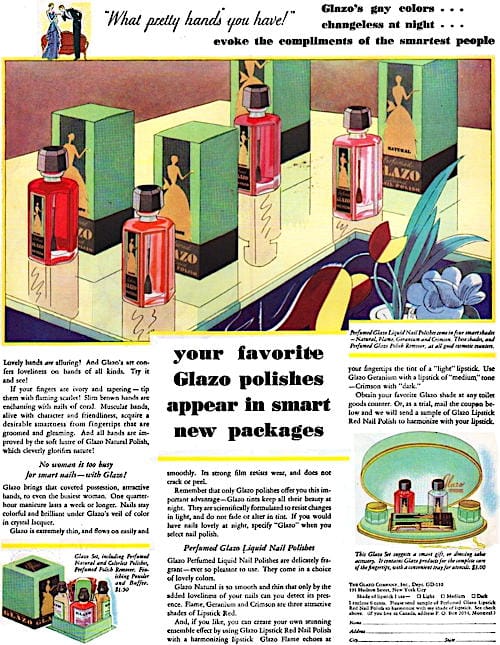
Above: 1930 Glazo Perfumed Nail Polishes with brushes built into the Bakelite cap. Glazo may have been the first American nail polish brand to do this.
Some products like the Glazo Twin Packs which contained the older Glazo Liquid Polish and Glazo Polish Remover remained in their older corked packaging for a while. Shades for the liquid polish in these twin packs sold by Northam Warren were Natural, Colorless, and Deep Shell, with Flame added in 1932.
Other innovations included Glazo Nail White, and Glazo Cuticle Remover Crème added in 1930, and Glazo Nicotine Remover, and Glazo Nail White Pencil which arrived in 1931. The nicotine remover appears to have been adopted from Peggy Sage, a company Northam Warren had bought in 1930. The nail whites look to have come from a similar products already sold by Cutex.
Glazo Nicotine Remover: “[Q]uickly banishes nicotine, ink, and other stains from the hands.”
Glazo Cuticle Remover Crème: “This soft, white cream gently removes excess cuticle, and leaves the edges smooth and even. It is simpler to use—applied directly from the convenient tube.”
Glazo Nail White Pencil: “[G]reen finished, with a convenient green sharpener to match.”
Replacing the corks with screw on Bakelite caps allowed Glazo to combine these into a wide range of manicure sets, some designed to sit on a dressing table, others packaged for travelling.
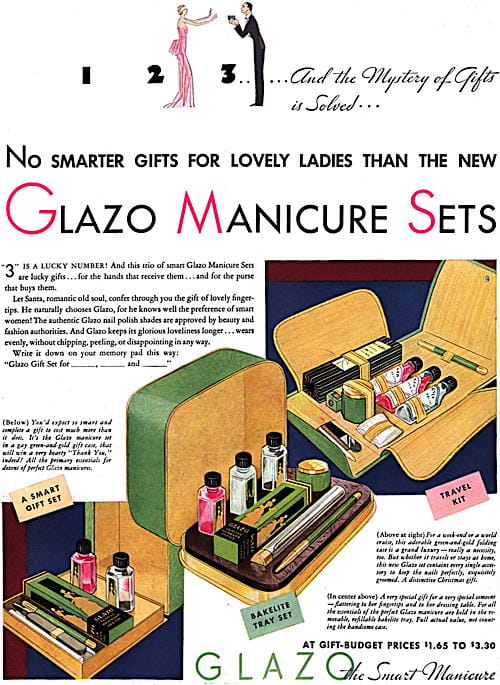
Above: 1932 Glazo Manicure sets.
In 1933, the distinction between perfumed and non-perfumed polishes disappeared following what may have been a reformulation of the polish. Glazo Nail Polish was also put into a new patented box (US patent: 1,974,466, 1934) with the six available shades – Natural, Shell, Flame, Geranium, Crimson, and Mandarin Red – printed on the pack. However, with the economy gripped by the Great Depression, Northam Warren lowered the price of the polish to US25¢ a bottle in 1933 and to US20¢ for a 75% larger bottle in 1935.
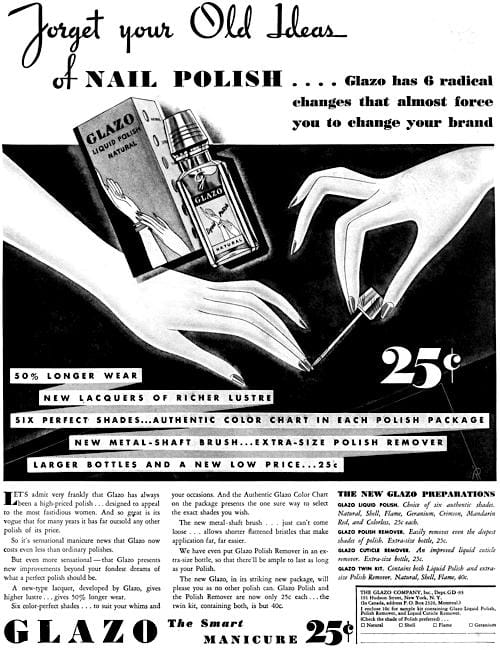
Above: 1932 Glazo Nail Polish in a new carton with the available shades printed on the side of the box.
Until 1936, all of the Glazo Nail polishes appear to have been coloured with dyes, so were translucent. The nail polish was only applied across the main part of the nail plate leaving the lunula (half moon) and free edge without any polish. This was common practice for early nail polishes with the lunula often drawn in if one was not present.
This practice changed when cream nail polishes were introduced, with Revlon leading the way in this trend in the United States. Cream nail polishes were coloured with pigments which made the nail polish opaque and they were generally spread to cover the entire nail plate including the lunula and free edge. Women found it much easier to apply nail polish this way and liked its more striking look. However, it was not without some risks. Leaving the free edge clear of polish made the polish less likely to chip.
Like other nail polish companies, Glazo eventually replaced its translucent polishes with cream types. This started with Old Rose, Thistle, Rust, Russet, Suntan, Dahlia, and Imperial Red shades in 1936 with Tropic, Congo, Spice, and Cabaña added in 1937. These new cream shades came in the US20¢ bottle but were also sold in a larger US25¢ bottle.
Glazo also added Oily Polish Remover in 1934 and Nail-Cote containing wax in 1937. Nail-Cote was to be used before and after applying Glazo Nail Polish so functioned both as a bottom and a top coat.
Glazo Oily Polish Remover: “[C]leans without drying the cuticle.”
Glazo Nail-Cote: “It prevents breaking or splitting nails and allows them to grow fashionable long. … [U]sed over polish prolongs its life and heightens the gloss, too.”
Later developments
By the late 1930s, Northam Warren was under strong competitive pressure from Revlon which had begun selling nail polish in 1932. A decision was made to dispose of the American business of Glazo, and it was sold along with the Elcaya line to Louis W. Halk in January, 1938. Halk had previously been a vice-president of Northam Warren and had also been in charge of Glazo sales in the United States for a while. He combined Glazo and Elcaya into a new company, Glazo Inc., based at 50 Paterson Avenue, East Rutherford, New Jersey.
See also: Elcaya
Following the sale, Glazo’s packaging was updated and three new shades were introduced – Rhumba, Ember, and Tara, with Emblem Red and Red-O-Red added in 1939, and Black Fire in 1941. Rhumba, Ember, and Tara were being sold by Glazo overseas which suggests Halk may have only bought the distribution rights in the United States with manufacturing still carried out by Northam Warren or had come to some sort of arrangement. Glazo Inc. was still around in 1945 but may have ceased operations soon after Halk died in 1945.
Transportation problems, closed borders, rationing and shortages of bottles and nitrocellulose made things very difficult for Northam Warren when the Second World War broke out, doubly so after America entered the war in December, 1941. Things were particularly problematic for Glazo sales overseas and Glazo sales in Britain, the British Dominions, and Europe appear to had stopped soon after the war started in September, 1939.
Available information on any of Glazo’s operations after the war is very sparse. I have been unable to find any suggestion that Glazo was resurrected in Britain or the British Dominions after 1945, with France being the only country where I have found evidence of it operating in Europe after the war.
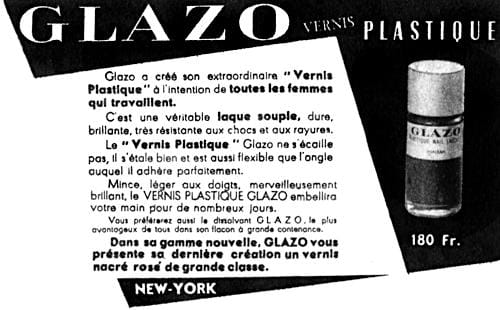
Above: 1953 Glazo (France).
The most recent advertisement I have seen for Glazo in France, that I can date, is from 1960. There is also evidence that Glazo had began selling indelible lipsticks in the late 1950s or early 1960s which would have enabled it to sell lipstick and nail polish in matching shades. The 1950s saw declining sales of nail polishes and Northam Warren sold all of his businesses to Chesebrough-Pond’s in 1960. They may have made the decision to sell off or abandon what remained of Glazo soon after that.
Timeline
| 1914 | Glazo Company established by William Henry Noll in Fort Wayne, Indiana. New products: Glazo Nail Polish. |
| 1918 | Glazo Co. bought by Edna Grace Albert who moves it to Cincinatti. |
| 1921 | New products: Glazo Polish Remover. |
| 1927 | New York office opened. |
| 1928 | Glazo bought by Northam Warren New products: Glazo Cuticle Oil. |
| 1929 | Glazo Co. created in New York. New products: Perfumed Glazo Nail Polish. |
| 1930 | Glazo repackaged New products: Glazo Nail White; and Glazo Cuticle Remover Crème |
| 1931 | New products: Glazo Nicotine Remover. |
| 1932 | Glazo sales force combined with Cutex. |
| 1933 | Glazo range repackaged. |
| 1934 | Glazo Ltd. founded in Britain. New products: Glazo Oily Polish Remover. |
| 1935 | Cream polish shades added. |
| 1937 | New products: Glazo Nail-Cote. |
| 1938 | Glazo, Inc. established by Louis W. Halk at East Rutherford, New Jersey. |
| 1960 | Chesebrough-Pond’s buys Northam Warren. |
First Posted: 29th February 2024
Sources
The American perfumer & essential oil review. (1906-1955). New York: Robbins Perfumer Co. [etc.].
The chemist and druggist. (1859-) London: Morgan Brothers.
The drug and cosmetic industry. (1932-1997). New York: Harcourt Brace Jovanovich [etc.].
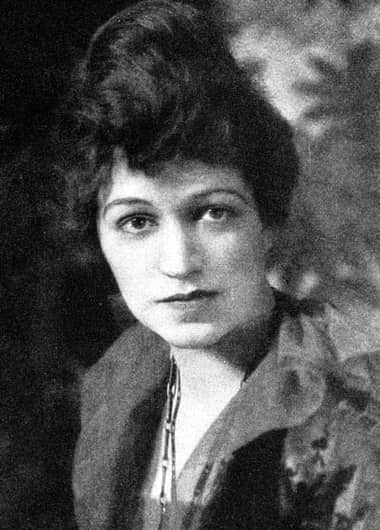
Edna Grace Albert (née Murphey) [1887-1969] also known as Patricia (Pat) Winter.
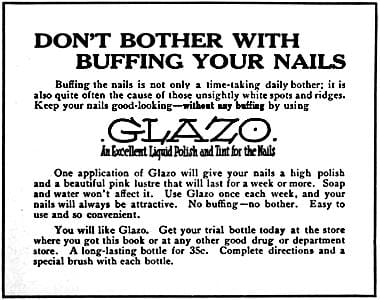
1917 Glazo Liquid Polish.
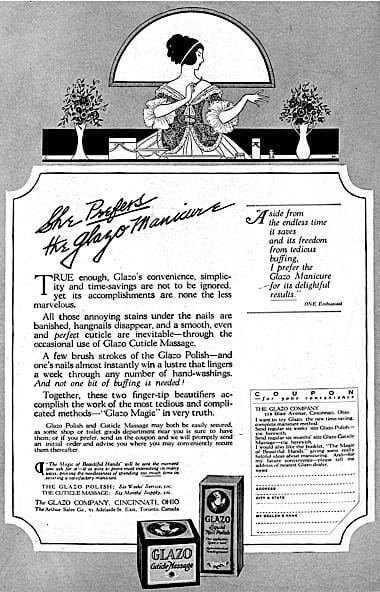
1920 Glazo Nail Polish and Massage Cream.
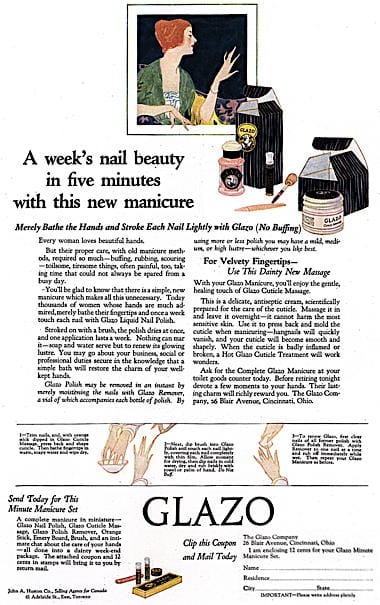
1921 Glazo Nail Polish and Massage Cream.
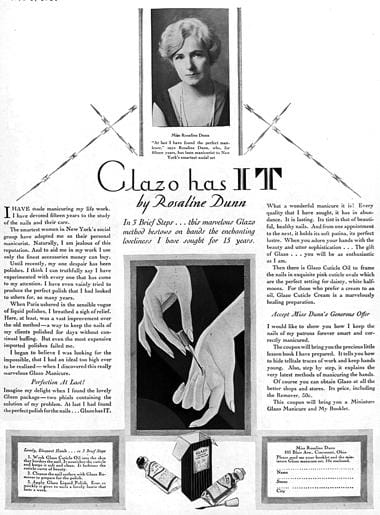
1928 Glazo has IT
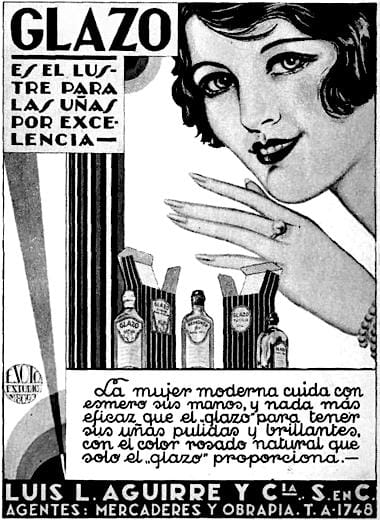
1929 Glazo (Cuba).
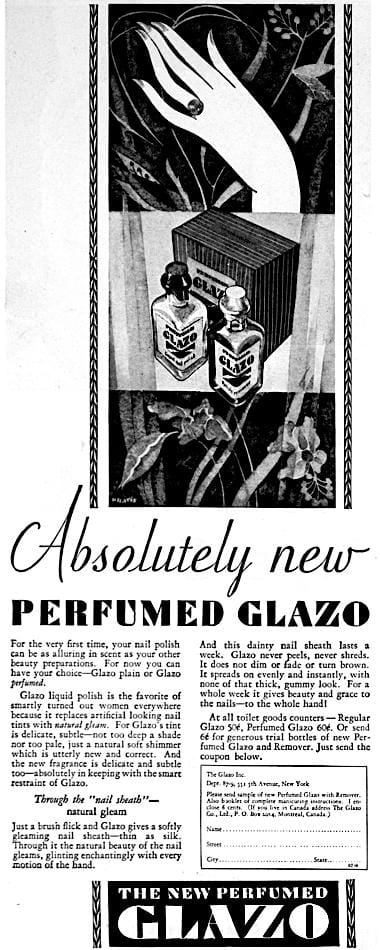
1929 Glazo Perfumed Nail Polish.
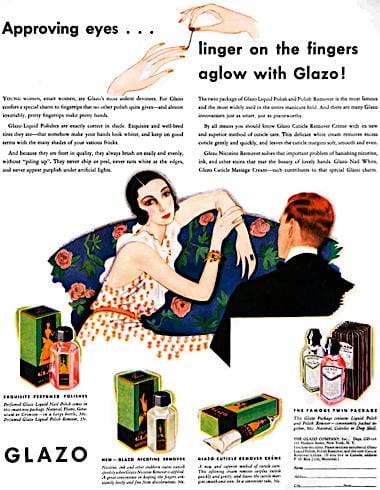
1931 Glazo Perfumed Nail Polish, Nicotine Remover, Cuticle Remover Crème, and Twin Pack.
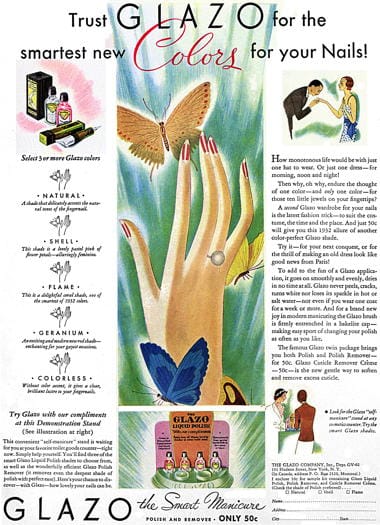
1932 Glazo shades. Note the free edge and lunula of the nail plate are still clear.
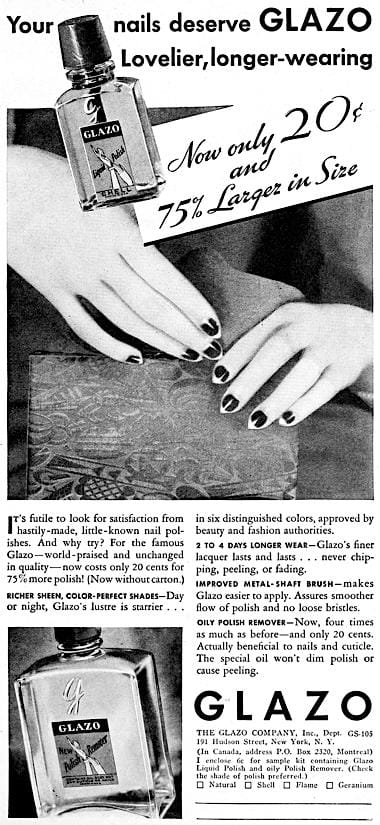
1935 Glazo Nail Polish.

1936 Glazo Nail Polish (Britain).
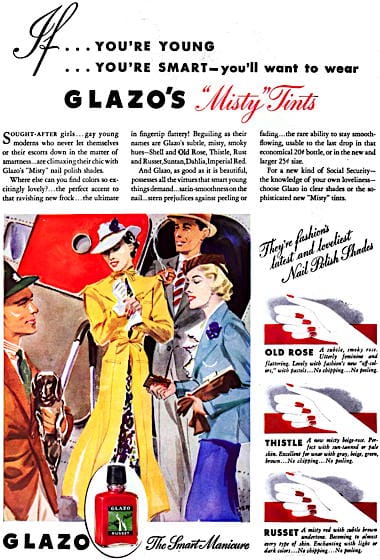
1936 Glazo Misty Tints.
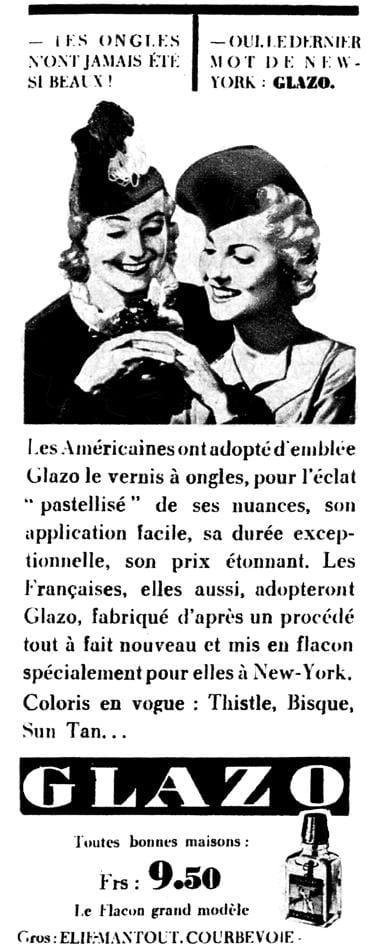
1938 Glazo Nail Polish (France).
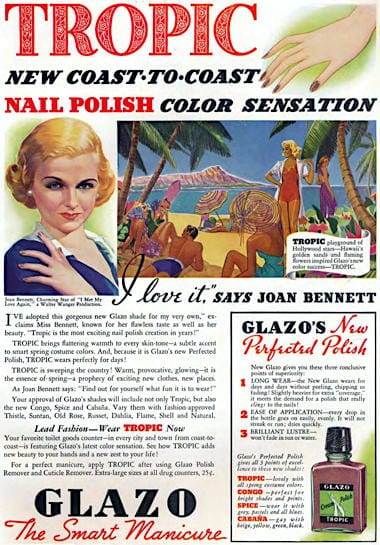
1938 Glazo Tropic shades.
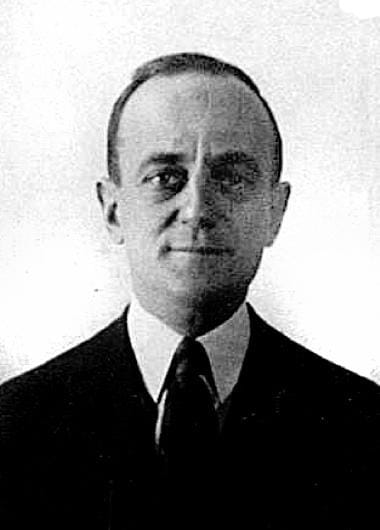
Louis William Halk [1882-1945]
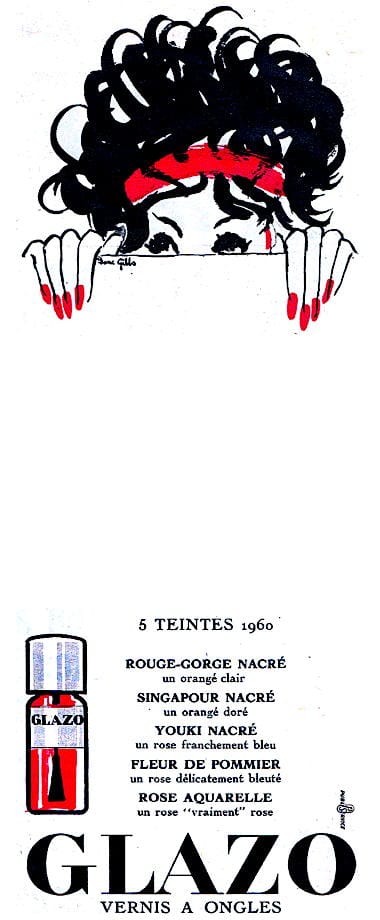
1960 Glazo Nail Polish (France).
